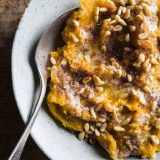Cookbook author Sabrina Ghayour gave herself a formidable task—harness the bold, savory meatiness that defines Middle Eastern feasts to transform vegetarian meals.
“It’s virtually illegal to be vegetarian in the Middle East,” says the Tehran-born Ghayour, who was raised in England. She’d made her reputation by focusing on simplicity and economy while showcasing the feasts and flavors of the Middle East. Her intent remained the same for her fourth cookbook, “Bazaar,” but she left out one significant element: the meat.
So the proud meat eater had other carnivores in mind as she developed the all-vegetarian recipes, which cast a wider net than previous books for a collection of “food from everywhere and nowhere.”
Take, for example, her mashed butternut squash, a solidly Western staple. She combines it with garlic, chili, tangy sumac and an ingredient she calls her secret weapon for vegan cooking: tahini. She turns to the ground sesame paste to lend nutty flavor and body to dishes that otherwise could fail to satisfy.
But she has a confession. “I stole it from the Chinese,” she says. “They use sesame paste in dan dan noodles, which has a thicker gravy, and at first I thought, how the hell do they do this?”
With her meat cheat in hand, Ghayour roasts halves of butternut squash for an hour, then combines the flesh with crushed garlic cloves and red pepper flakes. The mixture is cooked in a saucepan for 5 minutes, just long enough to lessen the raw bite of allium and meld the flavors. Tahini drizzled on top adds heft, while a couple pinches of sumac brighten the dish with color and tart acidity. Pine nuts reinforce the nuttiness of the tahini and contribute texture.
At Milk Street, we loved the bold, balanced flavors and textural contrast that Ghayour accomplished with so few ingredients, but found ourselves wanting the squash itself to be creamier. The solution lay in cutting the squash into 1½-inch cubes. This cuts the roasting time by half, to only about 30 minutes. And because the cubes had more surface area than the halves, we got more flavor thanks to better browning in the oven. Finally, starting with relatively small cubes broke up the fibers in the flesh (similar to cutting a flank steak against the grain), yielding a creamier mash with less time and effort required.
Cooking the mixture in a skillet instead of a narrower saucepan allowed more moisture to evaporate, condensing the flavors. And grating the garlic helped it blend better with the squash. We also increased the sumac to a full teaspoon for more pronounced acidity. The result: Ghayour’s satisfying squash, amplified and in half the time.




